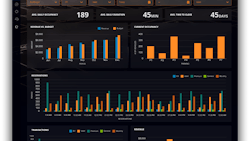Creating a Frictionless, Efficient, and Future-Proof Parking Ecosystem

-
How smart parking systems improve passenger experience
-
Why flexibility is critical in airport parking environments
-
The importance of integrating disconnected subsystems
-
How centralized data drives smarter operations
-
The role of structured data in automation and personalization
In an era where “enhancing the passenger experience” is crucial, airport operators must take a more proactive approach to reduce stress, letting travelers focus on enjoying their journey. Parking should offer a seamless experience from beginning to end — from reserving a spot, to transparent pricing, easy entry, wayfinding, EV charging, touchless payment and a quick exit. Yet operational efficiency and cost maximization must also be top priority.
Smart parking solutions — combining guidance systems, automated payment and touchless transactions, real-time reservation systems and EV charging capabilities — hold the promise to create a better user experience for the traveler, while increasing returns for facility operators. But in reality, this is no small task. Finding the right solution, integrating it into current systems, getting it to work seamlessly with other airport systems, and pulling out meaningful data can be a challenging and costly proposition.
Let’s look at some key success factors to keep in mind when embarking on a smart parking implementation.
Flexibility for Unique Needs
Flexibility is key within the airport environment. No two airports are the same. Even within the same airport —whether it’s a small regional airport or large international hub — no two days are the same. Flights get delayed, canceled, or rescheduled, requiring adjustable parking durations. Holidays or weather events can create a traffic nightmare. On-demand shuttles may need to accommodate unexpected return times.
This is why flexibility is critical not only to ensure the system meets current needs, but that any technology investment is scalable well into the future. Open systems that use modular systems are not only adaptable but can leverage current equipment and infrastructure. Unlike proprietary systems, they use standardized protocols, APIs, enhanced security levels, and modular architectures to enable compatibility, futureproofing, and customization.
Airports should first assess specific needs to select the features that align with their operational goals. Pre-booking and touchless payments can offer a frictionless experience. Smart sensors and digital displays can provide real-time data on parking space occupancy. End-to-end EV charging capabilities can be added, offering reservable charging and additional revenue streams.
Connecting the Disconnected
Most parking technology infrastructure consists of a mix of subsystems, such as parking access and revenue control system (PARCS), parking guidance system (PGS), online booking system (OBS), access control system (ACS), license plate reader (LPR), EV management system and valet management system. Typically, these subsystems serve as point solutions for a single capability with limited, if any, interaction between subsystems. The result is a complex web of legacy and new systems that are inefficient to manage, cumbersome to use and not configured to share insights from data collection.
It is important to find a solution that brings together data from parking subsystems in a way that enables it to flow seamlessly into a unified platform. APIs can aggregate data from these subsystems into a user-friendly dashboard. This will enable streamlined workflows to reduce time and costs associated with managing multiple parking systems. Moreover, it can deliver real-time data for operations, new revenue streams and passenger experience improvements.
Another consideration is integration with third-party systems (such as flight schedules or EV charging) to further enhance functionality and insights.
Centralized Control
A centralized control center (driven by a single data source) with a consolidated view across all subsystems is necessary to make more informed, longer-range, and less-reactive decisions. Centralized data can provide insights from the entire parking experience, all in one view. When combined with AI, and machine learning, valuable patterns and trends can be uncovered. Airport teams can track key metrics such as capacity and traffic flow to help eliminate congestion — reducing both driver frustration and the fuel-burning waste of circling to find an open space.
The dashboards should also be easy to customize so different users have access to the information they need, when they need it. Whether it’s parking teams, maintenance personnel or management, users should be able to quickly and easily access the data-driven insights most relevant to their work.
Meaningful Data
Solutions are available that transform unstructured data into structured data into one record. This “structured data” can then be easily queried and analyzed, supporting applications like real-time availability tracking, reservation and access control, and payment information.
Having access to structured data across all subsystems enables:
- 100% read rate of license plates with data shared between PARCS/LPR and PGS
- Automated reservation changes with data shared between OBS, PARCS, Valet and PGS
- Garage automation technology to enable the frictionless experience
- Single point of payment with data shared between the EV management system and PARCS
This level of intelligence not only supports more automation but allows for more personalized experiences and premium services such as EV charging or valet.
Smart parking technologies hold the promise of creating a frictionless, efficient and future-proof airport parking experience. But airports should remain cautious of technology pitfalls and risks. Implementation should prioritize a centralized and open technology approach — where real-time insights, flexibility and scalability combine to create an integrated, customer-focused, and future-ready parking ecosystem.
About the Author

Dana Hasty
Dana Hasty serves as senior director of ABM Vantage for Aviation at ABM Industries, leading platform strategy development and implementation. She was promoted to this role in November 2024 after serving as senior director of finance for ABM Aviation. Before joining ABM, Hasty worked for the Coca-Cola Company in progressively senior finance roles. Hasty earned an Master of Business Administration in finance from College of Business at the University of Central Florida and a Bachelor of Science degree in business administration from the same institution.